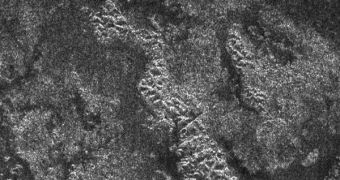Saturn's moon Titan has captured for a long time the imagination of scientists, who currently even envision a nuclear-powered mission for the satellite, including several components. All the interest stems from the fact that observations of the celestial body, performed by the Cassini spacecraft, have revealed peculiar structures on its surface, as well as strange lakes of hydrocarbon, which appear to be functioning in very much the same way our water lakes do here, on Earth, NewScientist reports.
In a recent set of studies, it was demonstrated that the lakes on Titan featured abundant concentrations of the chemical acetylene, which astrobiologists believe could serve as a primitive food source for basic organisms. The idea that life forms able to resist in the moon's harsh environment may exist is not so far-fetched. Other forms of life may adapt to different chemicals than the ones we rely on, such as carbon, oxygen and nitrogen. It may not be out of the question that Titan's hydrocarbon lakes, or Enceladus' underground ocean, may support their own forms of life, even if only primitive.
Bacteria retrieved from deep within Antarctica's ice crusts have proven that the small organisms can easily adapt to living at ultra-cold temperatures for thousands of years, in areas where food sources are non-existent, or extremely scarce. This is not the case on Titan, where the cold would be the only problem. However, the large concentration of acetylene could more than make up for the drawback. Therefore, scientists are actually excited that future missions on the Saturnine moon could reveal the first signs of extraterrestrial life.
According to the most recent estimates, the average temperature on the surface of Titan is no more than -180° Celsius, the equivalent of -310 degrees Fahrenheit. A group of researchers proposed as far back as 2005 that potential microbes or bacteria on the moon could be consuming the stuff, which falls on the surface of the lakes after forming in the atmosphere. The organisms could be combining the chemical with hydrogen, in order to get a full “meal.” It is currently believed that acetylene makes up one part in 100 of all hydrocarbons in Titan's lakes.

 14 DAY TRIAL //
14 DAY TRIAL //